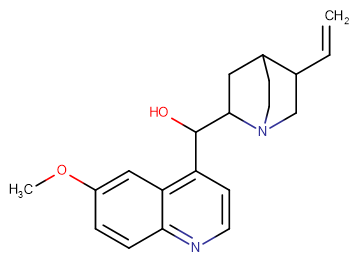
Quinine
CAS No. 130-95-0
Quinine( NSC 192949 )
Catalog No. M11236 CAS No. 130-95-0
An alkaloid derived from the bark of the cinchona tree. It is used as an antimalarial drug, and is the active ingredient in extracts of the cinchona.
Purity : >98% (HPLC)
 COA
COA
 Datasheet
Datasheet
 HNMR
HNMR
 HPLC
HPLC
 MSDS
MSDS
 Handing Instructions
Handing Instructions
| Size | Price / USD | Stock | Quantity |
| 500MG | 35 | In Stock |


|
| 1G | 42 | In Stock |


|
Biological Information
-
Product NameQuinine
-
NoteResearch use only, not for human use.
-
Brief DescriptionAn alkaloid derived from the bark of the cinchona tree. It is used as an antimalarial drug, and is the active ingredient in extracts of the cinchona.
-
DescriptionAn alkaloid derived from the bark of the cinchona tree. It is used as an antimalarial drug, and is the active ingredient in extracts of the cinchona that have been used for that purpose since before 1633. Quinine is also a mild antipyretic and analgesic and has been used in common cold preparations for that purpose. It was used commonly and as a bitter and flavoring agent, and is still useful for the treatment of babesiosis. Quinine is also useful in some muscular disorders, especially nocturnal leg cramps and myotonia congenita, because of its direct effects on muscle membrane and sodium channels. The mechanisms of its antimalarial effects are not well understood. (In Vitro):Quinine (150 μM, 30 min) inhibits the proliferation and cytostatic effects of DENV (Dengue virus) in human hepatocarcinoma HepG2 cell line.Quinine (37.5-150 μM, 24 hours) significantly reduces viral DENV RNA and protein levels in a dose-dependent manner in human hepatocarcinoma HepG2 cell line.(In Vivo):Quinine (oral gavage, 12 or 15 mg/kg, every week, 16 weeks) has some tumor suppressing effect on skin cancer in Swiss albino mice.Quinine (oral gavage, 10 mg/kg, everyday, 8 weeks) causes a decrease in the antioxidant defense system of rat testicular tissue such as SOD, CAT and GSH enzyme activity in male adult albino rats.
-
In VitroCell Proliferation Assay Cell Line:Human hepatocarcinoma cell line (HepG2) Concentration:150 μM Incubation Time:30 min Result:Inhibited DENV virus replication with 19% yield compared to untreated. Reduced DENV-positive cells from 23.28% to 12.05% in a dose-dependent manner.
-
In VivoAnimal Model:Swiss albino mice 7-8-weeks (weighing 24 g) Dosage:12 mg/kg, 15 mg/kg Administration:Oral gavage; every week; 16 weeks Result:Resulted in a significant reduction in tumor size and weight at 12 mg/kg and little effect at higher dose of 15 mg/kg.
-
SynonymsNSC 192949
-
PathwayMembrane Transporter/Ion Channel
-
TargetOther Targets
-
RecptorFe(II)-protoporphyrin IX| Platelet glycoprotein IX| Potassium Channel
-
Research AreaInfection
-
Indication——
Chemical Information
-
CAS Number130-95-0
-
Formula Weight324.42
-
Molecular FormulaC20H24N2O2
-
Purity>98% (HPLC)
-
SolubilitySoluble in Water
-
SMILESCOC1=CC2=C(C=CN=C2C=C1)C(C3CC4CCN3CC4C=C)O
-
Chemical Name(R)-[(2S,4S,5R)-5-ethenyl-1-azabicyclo[2.2.2]octan-2-yl]-(6-methoxyquinolin-4-yl)methanol
Shipping & Storage Information
-
Storage(-20℃)
-
ShippingWith Ice Pack
-
Stability≥ 2 years
Reference
1.Alumasa JN, et al. J Inorg Biochem. 2010 Sep 2
molnova catalog



related products
-
Emamectin Benzoate
Emamectin Benzoate, by binding gamma-aminobutyric acid (GABA) receptor and glutamate-gated chloride channels disrupting nerve signals within arthropods, acts as a chloride channel activator.
-
Chlorothymol
Chlorothymol is a disinfectant used in oral.
-
Etomidate hydrochlor...
Etomidate hydrochloride is a potent agonist of GABAA receptor. It is a neurological drug and effective parenteral medication and has the potential for management of endogenous hypercortisolaemia.



 Cart
Cart
 sales@molnova.com
sales@molnova.com


